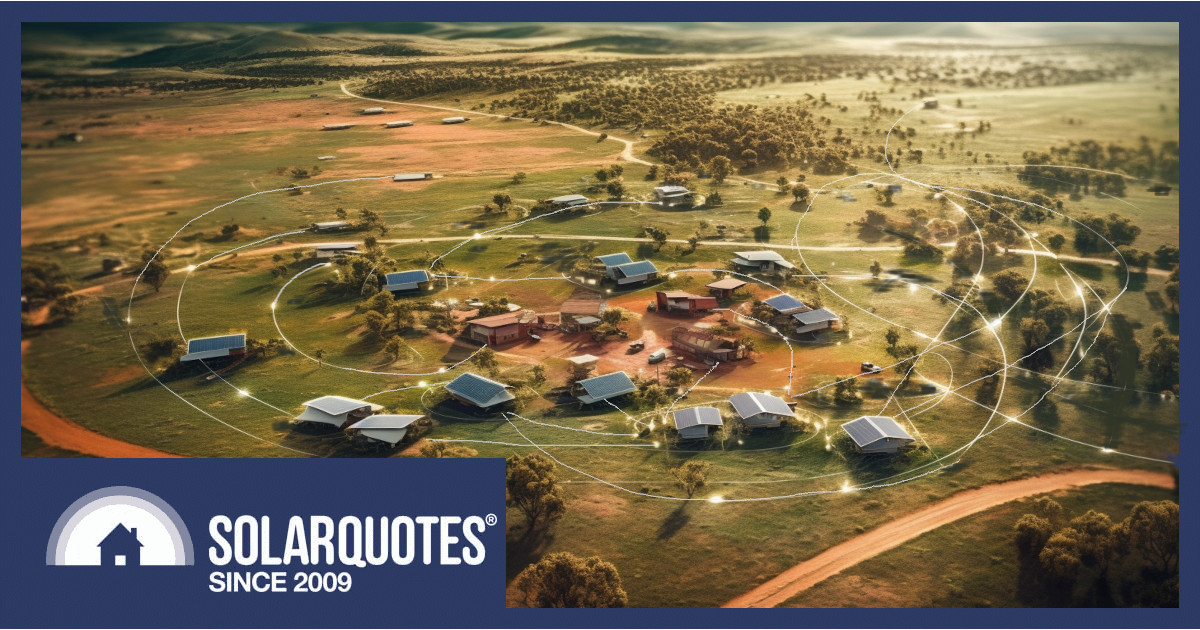
South Australia – where more than 1-in-3 homes have rooftop solar – is once again leading the charge in solar energy integration with the introduction of Flexible Exports for new solar connections, starting in earnest this month (July 2023).
But don’t worry; this is good news. Flexible Exports (also called Dynamic Exports) mean the grid will be more stable, and you’ll be able to export more energy than before – up to 10kW per phase.
However, the reliance on home WiFi as a key comms link raises some questions about its long-term robustness. After extensive trials of the world-leading program and some months of delay in implementation, we now have a new approval and compliance platform. But is WiFi the best solution for this ambitious project?
In this post, I’ll delve into the challenges posed by using WiFi in the Flexible Exports program and explore potential alternatives. I’ll also share my experiences installing connectivity in the suburbs and outback.
For any South Australian solar installers reading this – please be aware you need to be across the new requirements to maintain a rolling 90% compliance or SA Power Networks (SAPN) won’t let you lodge any new jobs.
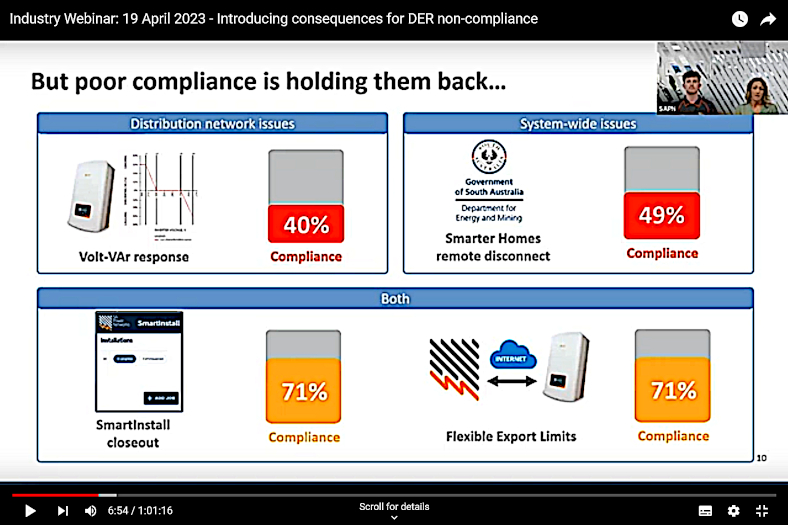
According to this webinar, SAPN will force better compliance using the new “smart install” platform
The National Impact of South Australia’s Dynamic Exports Program
South Australia’s distribution network operator, SAPN, has done a much better job this time after a less-than-stellar introduction of “smarter homes” in 2020.
The east coast may consider us a backwater, but SAPN is doing the testing and certification everyone will need as renewables continue to march out across the country. If you have more than a passing interest, let Victoria know we need national consistency with this survey they’re running. Otherwise, we might all end up with the silly regulations from Queensland.
Compliance Requirements
Not every SA address is eligible right now, but over the coming year dynamic controls will become the standard, and so you’ll need capable equipment from an approved list.
While these compliance requirements are crucial, another factor is equally important and potentially problematic: the reliance on home WiFi.
Home WiFi as the Weakest Link in Flexible Exports
WiFi is both a boon and a bane for consumers. When the banging, drilling, and shouting has died down, you might think your solar installation is finished, but setting up connectivity can be a whole other job. We know trusty wired ethernet is more reliable than fickle WiFi, but few consumers are willing to pay for the extra effort.
So those with sober statutory responsibilities to run the electricity network are left using a last-mile connection – home WiFi – akin to tin cans and a taught sting. The largest aggregated generator in SA, rooftop solar, needs something more reliable than WiFi.
Relying on dodgy customer-owned WiFi for controlling and managing our energy systems is a liability. When routers fail, telcos are switched, or residents focus more on a Netflix account than their electricity account, things will go unnoticed and unattended. And relying on real estate agents? Ye gods, that’s not the kind of energy future we want.
Now I’ve raised this issue with many people, and from what I can gather, SAPN embraced WiFi because they had to deploy something quickly. When “Smarter Homes” was announced, it had about two whole days of industry consultation and a six-week lead time (proving bureaucracy can move quickly when they want to). The new rules required connectivity but nobody even had a solution ready for market in week one. Now Flexible Exports is up and running, they’ll have better visibility of delinquent connections, but getting them back online might not be so simple.
Navigating the Maze of Internet Connectivity Options
WiFi? modem? ethernet? dongle? router? 4G? 2.4Ghz? Gahhhh..!
As a solar installer, I’ve often lamented that the internet has amazing potential, mainly to ruin my day with bad connectivity or commissioning problems. I shouldn’t complain, though; it happens to the very best of us sometimes. I can, however, offer some observations about what I’ve found effective in a varied set of circumstances and a few of the pitfalls you may encounter.
Recommended Solutions for Reliable Internet Connectivity
- Hardwired.
It’s simple. Nothing beats a Cat6 cable that physically connects your inverter straight to the modem/router/hub in your premises. Put a big important label on it, telling people what it’s doing and that it can’t be disconnected. - 4G dongle.
Arguably simpler, fast, and just as reliable. Slot a SIM card into it and then it talks directly to the local mobile phone tower. Makers like Sungrow offer a unit that plugs straight into your inverter. Others recommend a third-party device that can be wired or WiFi connected as a dedicated link. Once hidden inside the inverter, these are also a pretty good option. The major drawback is the cost of a SIM. The volume of data needed is minuscule, but you’ll still pay up $5 to $15/month. My best option was to share a phone plan, but it’s still $60pa or 16 cents per day added to your power bill. - I have a dream – use the smart meter’s comms. Your retail smart meter has a wireless comms link already. Imagine if the mandated solar hardware could connect seamlessly to the mandated retail meter. Given an RJ45 port on the meter, installers would beat a path to it just because it’s simple, easy, consistent, standardised, secure, reliable, and cheap.
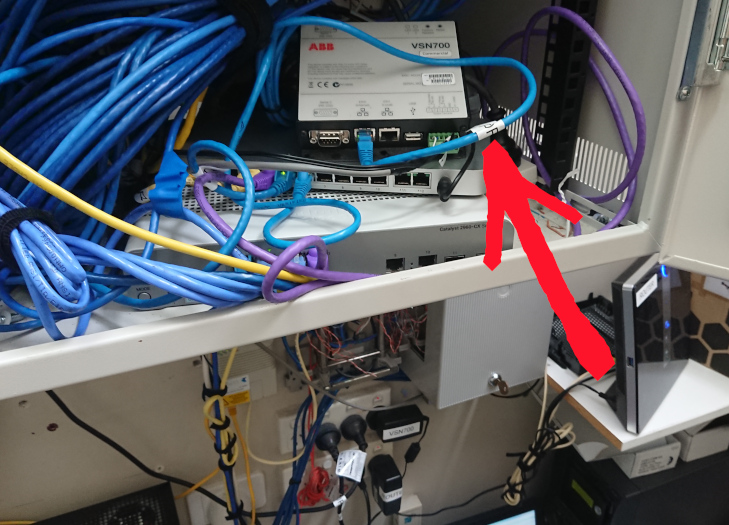
The IT crowd might be messy but at least this old ABB solar logger had a proper label on the cable.
Beware of Crap 4G Hardware.
This cute white WiFi cheapie from Alcatel/Optus cost a bomb, as dozens of them had to be replaced with the black units pictured below. It wasn’t until they were in service that it was realised they turn themselves off when there is little internet traffic. Great for saving data but useless for fleet monitoring.
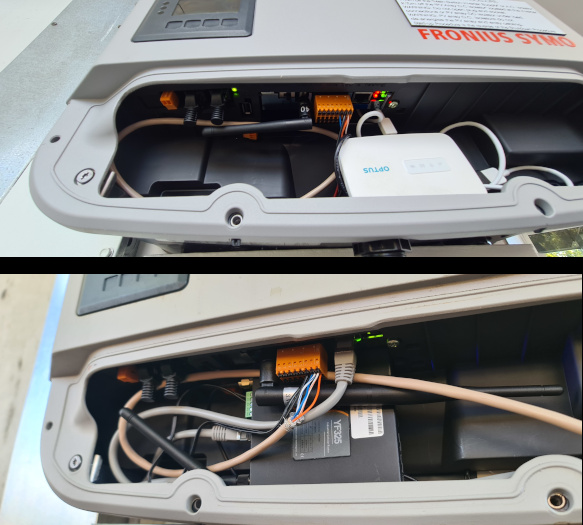
You can hide things inside a Fronius inverter, screw the cover on and they’re safe.
Whatever dongle you or your installer chooses, it must be able to stay on all the time AND go through a power outage without needing a manual reset. I recently made a 4-hour round trip to replace a $480 mobile internet router because although I insisted on a wired connection and the 70-year-old, hearing-impaired customer did find the reset button, he wasn’t savvy enough to scroll through menus to reactivate the ethernet port. My tired bones are yet to shove that particular device up the proverbial backside of a behemoth telco. Turns out the cheaper simpler option was better.
Making WiFi Work: Tips for Successful Implementation
Fronius don’t offer a hard-wired connection for the award-winning Wattpilot EV charger, but you must be conscious of the connection. Many people are fascinated by their solar monitoring for a fortnight, but once the novelty fades and you lose the app with a new phone, it can go ignored.
This proves disastrous with Enphase, for example. Despite the premium price, your Enphase Envoy only has a 5-year warranty (half or a third that of the inverters). If the envoy fails or you’re otherwise disconnected from the internet for 45 days, then the whole system warranty is deemed void. Or the Envoy may just be bricked without internet. I consider that a rort.
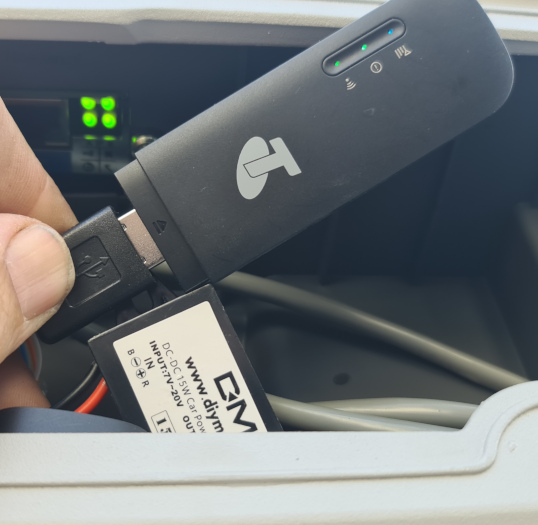
This little Huawei 4G dongle is recommended by Fronius. With a small DC power supply and all the green lights on, this is a winner.
Remote Area Solar Power Systems Without Internet
We often installed remote area power systems. Whether they’re suburban fringe, a couple of hours North of Kimba, or 900km into the dead heart, being able to see and make configuration changes via an internet connection is just priceless. It sometimes meant offering a larger solution, though.
For example:
- install a 4G router right next to the power system with hard-wired data to the inverter & battery
- add an external aerial to actually pick up the phone tower signal
- with a solid connection made to the outside world, connect the house using a Ubiqti wireless bridge
- or broadcast WiFi from the power system shed for other devices like phones and security cameras to pick up.
Obviously, these systems had nothing to do with SAPN or the grid, but they do prove how to deploy hardware, which saves digging a lot of trenches on properties where the utility meter, the house, and the shed with the solar power were all 100 metres from each other.
If you have a complex install, getting a WiFi networking specialist involved could be the best option, especially if, for instance, you have a business with tight internet security. I have wasted hours chasing documents for an IT guru who only works Tuesday, just to find out a solar inverter needs to be specifically whitelisted to work. And dealing with the education department WiFi? Forget about it.

The green tick of connection helped out by a Ubiqt wireless bridge which I made a little tiny shed for.
2.4 GHz Can Be A Trap
Many solar inverters will only talk on a 2.4GHz signal, so you must ensure your new 5G device supports the old standard. Signal strengths vary by brand and model, so while your sales consultant might wave their phone around and say there’s plenty of reception, as an installer, I would love to have an external aerial option for a Fronius inverter, and everyone I’ve spoken to says the Goodwe Homekit smart meter is sadly a joke, in desperate need of hard wiring.
It’s worth asking your installer who will pay if some extra work is needed because they can’t get a signal. It can be as simple as a plug-in WiFi extender, but that’s another layer of complexity, a weak link, and $120 extra might prove a sticking point.
We’ve Gotta Make This Work
So, there you have it. South Australia’s Flexible Exports initiative is a great step forward, but it’s not without challenges. While convenient, reliance on home WiFi presents a host of potential issues that could hinder the program’s success. But we’re not just here to point out problems – I’ve also explored a range of practical solutions, from hardwired connections to 4G dongles.
It’s up to us – installers and system owners – to help make it work. Whether dealing with the quirks of WiFi, finding ways to connect remote areas, or simply taking responsibility for keeping our inverter’s WiFi password current, we’re in this together. And with a bit of ingenuity and perseverance, we’re confident that we can make the Flexible Exports program work for SA, which will lead the way for all new rooftop solar owners in Australia.

 RSS - Posts
RSS - Posts



Totally agree that WiFi will be problematic. But as long as consumers are incentivised with the static export restriction when not connected, this will self rectify.
Wi-Fi will likely be more resilient from rodent attacks as it’s comprised of “green steam”.
Range anxiety can be overcome with the use of quality infrastructure which usually costs far less in the long term due to higher reliability factor/s.
I wonder what will happen when people move house and the new owners move in – whose responsibility will it be to connect up the Inverter to the new WIFI ?
We already see enough of these on Whirlpool with people not knowing how to get into the monitoring adn setup of their systems to connect to a new WIFI network
On the point of 2.4GHz vs 5GHz – for this kind of application 2.4GHz will be better, as 2.4GHz has better penetration (through walls – which is important as inverters are usually outdoors) and distance. 2.4GHz WiFi will still be with us because of these characteristics. It is probably better than 5GHz for IoT applications because of it’s better distance characteristics.
I was looking at installing solar in next 3-4 months, but this flexible export program now available in my area is causing me to think twice about whether it is now viable.
I only have prepaid mobile wifi internet at home which suits my limited needs. If I had to sign up for a monthly internet plan at approx. $60pm to allow flexible exports, it would cost me more in internet fees than I would ever save with solar. I also would never have a system large enough to allow exports of 10kw.
The only other option as I understand it is to go for fixed export of 1.5kw. Therefore, rather than following the mantra of “fill your roof with solar”, I would be better off installing a basic system which just covers my own usage, plus the possibility of being able to export up to 1.5kw. I don’t know if this saving would justify the cost of installing even a basic solar system at all, as I am not a big power user.
It can still make sense to fill your roof with solar with 1.5kW export – but you’d need to run the numbers. You can also buy data-only SIMs from as little as $5 per month.
But – agreed – it is another hoop to jump through for people getting solar.
Agree ! WiFI is the Archilles heel and I doubt it will ever work to a satisfactory level. Here where I am, just 60km from Adelaide, there is no 4G or 5G reception. Whilst 80 -90% of Australia will have reception, do we really want to exclude that last 10% ?
Will inverters have the option of being opted out and not go into hibernation because there is no connection ?
There is indeed an old technology that is available to reach everybody – data over power lines – this worked in the past, why not use it now ? You do not need 1Gbs connection – a mere 300bps will get the job done !
I see a disaster in the making.
I think a few things are getting conflated here. WiFi is only the connection between your Internet router and the the inverter. In the case where you don’t have 4G or 5G, you can hopefully still get some sort of Internet connection – even if it is StarLink. That said, WiFi may still not be the best technology to get between you inverter and your StarLink router. We need however to be clear to separate the discussion about the technology used to get between the inverter and your Internet router, and the technology used to deliver your internet connection.
True, it just shows how confusing and complicated things can get. Currently I have WiFi between my SMA inverter and the router – no problem there. I connect to the internet through Skymesh, but have not allowed the Inverter to talk to SAPN or SMA headquarters. I am no newbie to setting up networks, but it took me the best part of a morning navigating a new router and get the Inverter to talk properly to my home network. I had to replace a failed router, hence the issue. The reason I am not keen to have SMA or SAPN connect to my homework is purely one of security. As it stood 12months ago, SAPN expects the homeowner to be wholy responsible for the security of the connection. In my opinion, this is unreasonable. SAPN must also take some responsibility. Until such time as they do, I am having none of it.
Starlink isn’t a cheap option though – $924 for the hardware, plus $139 per month for the connection whereas basic internet and landline is less than half that. Of course if you live in an area that has no cell reception and either lacks landline access, or has it but Telstra won’t fix it …
Check with alternate network suppliers. I currently have full FTH in my regional village, and pay $40.39 per month and receive 100 Gb per month and consume an average of 50 Gb per month.
I won’t mention our aversion to anti-social media or streamers !!
Dr Pieter thank you for your insights.
And forewarned is forearmed on this topic:-
Solar PV Installations Monitoring & Control technology (it’s not just for system owners).
On-Grid Solar installations already have in place rules and regulations (via a written contract already in place) that networks and electricity retailers are entitled to enforce with customers (commonly referred to as the network service agreement fine print). These contracts are all encompassing ones formulated by the networks and electricity retailers without negotiation with the customer.
Importantly, these contracts involve customers agreeing to allow utilities to control the entire “system to grid interface” functionality of a customers solar /battery installation, and particularly system performance as it applies to grid feed in power and battery system charging and discharging logic controls.
As the number of grid connect systems increase, the more sophisticated will become the “system to grid interface” control algorithms, applied to customers systems.
Third party “approved by the network” monitoring and control systems (similar to the current network smart metering arrangements) will become mandated by networks to be fitted by customers to their systems (at the customers cost) in order to be eligible for an initial On-Grid connect approval. In the case of existing systems, the owners will be given a short period to retrofit a third party “approved by the network” monitoring and control system, to remain compliant as an On-Grid installation.
System owners who breech the connection contract T&C’s will be accountable I assume.
We will be seeing moves from state legislators in this direction soon.
Lawrence Coomber
Please tell me the specification for this Flexi upload has some fail safe built in. The internet is not a guaranteed to work service! Is the scenario covered when everyone is set to 10kw upload and the comms go down the inverts all default to off or low after some period of time as a dead man’s switch. Surely this is covered. If this is so, flakey wifi isn’t so much an issue as inverters default to Xkhw exports and don’t pose a danger to the grid.
If the inverter can’t contact the mothership, it defaults to 1.5kW export limit until the connection is reestablished.
There is a separate issue we need to deal with here when looking at inverters essentially “accepting commands” obtained via the Internet, namely security. As a general rule it would be bad for inverters to be directly accessible via the Internet. Many, such as Fronius, have RESTful APIs which, while read only, are accessible without any security. That means if you have network access to a Fronius inverter, you can pull data from it without any authentication or authorisation. The second, and more important, question is how secure the communication which controls the exports of an inverter is. Given that it is outbound from the inverter, I expect that it is most susceptible to Man in the Middle (MITM) attacks. Could a threat actor tamper with the export settings of inverters? Another question is whether an unscrupulous solar owner could tamper with the communication to prevent the exports from an inverter ever being reduced? To avoid the latter kind of attack, the commands sent to the inverter would need to be cryptographically signed so that the software on the inverter can verify that they are genuine.
Agree.
The powers that be may be missing the boat somewhat by not considering existing load control infrastructure such as Ripple Control. I have yet to see an argument as to why that is not feasible. It would be easy to insert a control signal midway between the tones currently used to control load relays. Lets say at 1200Hz. With that tone. existing circuits will not be affected. A low rate binary signal at 75bps using 8-bits will allow as fine a control as anybody could ever want. The inverter is already connected to the powerline, a simple circuit can feed that tone to the central processing unit which can set the export level accordingly. No security issues !
Sometimes we dismiss old technology as outdated. This is sometimes a mistake. The complexity of an internet connection is not required for effective load control.
Forewarned is forearmed on this topic:-
Solar PV Installations Monitoring & Control technology (it’s not just for system owners).
On-Grid Solar installations already have in place rules and regulations (via a written contract already in place) that networks and electricity retailers are entitled to enforce with customers (commonly referred to as the network service agreement fine print). These contracts are all encompassing ones formulated by the networks and electricity retailers without negotiation with the customer.
Importantly, these contracts involve customers agreeing to allow utilities to control the entire “system to grid interface” functionality of a customers solar /battery installation, and particularly system performance as it applies to grid feed in power and battery system charging and discharging logic controls.
As the number of grid connect systems increase, the more sophisticated will become the “system to grid interface” control algorithms, applied to customers systems.
Third party “approved by the network” monitoring and control systems (similar to the current network smart metering arrangements) will become mandated by networks to be fitted by customers to their systems (at the customers cost) in order to be eligible for an initial On-Grid connect approval. In the case of existing systems, the owners will be given a short period to retrofit a third party “approved by the network” monitoring and control system, to remain compliant as an On-Grid installation.
System owners who breech the connection contract T&C’s will be accountable I assume.
We will be seeing moves from state legislators in this direction soon.
Lawrence Coomber
Interesting view. The authorities can exercise the nuclear option of forcing compliance. But I wonder how well that will go down with consumers.
Soon batteries may be cheap enough to go off-grid and this is an option I am already contemplating this. In the meantime, my original contract is with ETSA, not SAPN. In addition, nothing in that contract stipulated compliance with respect to remote control.
There is also the issue of low feed-in tariff. It dropped again this July, to the point where I suspect many punters may just say, “Forget it”, and set their inverters to 0 feed-in. I am also considering a diverter at this stage that will move in that direction. The result is that soon, it may not be worth it for customers to export given the low feed-in tariff and compliance costs – this must surely weigh on the minds of the powers that be ?
I will be watching with bells on – as the old saying goes.
The problem with “going off grid” is that there’s invariably a week you’ll need some backup, and the neighbours won’t tolerate a generator wailing for 5 hours every other night. The grid is far more reliable anyway, and at a dollar a day for access, well cheaper than just having your genny serviced, let alone pouring fuel on it.
The grid is a common good that we should maintain to share energy, just like the sewer and water supply. If they crank the prices up too far they’ll just accelerate the death spiral of fixed costs being concentrated on those who can afford it least. You end up with poor people getting food poisoning without a fridge or burning their house down with candles. (Andrew Bolt’s wet dream?)
I think once we get a handle on it there will be perfectly workable solutions but right now it’s being introduced with admirable speed. Overall it’s a good thing and not a moment too soon, seeing as we’ve wasted a decade or more on the stup!d climate wars.
Given a carbon tax to drive investment we would have been in a far better place by now. Still the renewable generation per Australian is world leading, all we need now is the EV fleet. China is already at 30% in their vehicle fleet and with some bi-directional charging we could really use the storage on grid.
Anthony, the bureaucrats need to do it wrong, back up, and have another go or three. Eventually we’ll have something workable. (The climate motivator is changing up the gears annually now. The Antarctic Sea Ice extent graph for 2023 has jumped right outside the normal cycle range, so the experiment may be about to become seriously interesting.)
Presumably it’s 4G dongles that are on our electricity and water meters now. They seem to work; last week I received a notification of a water leak that their snoopy meter had logged. I was a bit slow to deal with it, and received another message saying it’s still leaking. This stuff can be made to be useful, it seems.
As there’s one of them on the electricity meter (which they made us pay for despite the benefits being exclusively theirs), using that for feed-in control seems as ideal as a dream. OK, it’ll have to be upgraded (replaced), and we’ll pay again, I guess.
But maybe the retailers don’t care. As soon as your inverter stops receiving a network management “OK to feed” heartbeat, for whatever reason, it defaults to 1.5 kW maximum. That works for the network, without requiring reliability of the comms connection. The aggregate data network traffic will still be vanishingly small in amongst the Netflix downloads.
I think it’s important to also think about the risks this poses. linking Chinese inverters like Huawei to home WIFI is a cyber security risk and opens thousands of backdoors to our national grid.
Perhaps the most productive way to chop essential production in a time of great need would be to mimic the legitimate general throttling messages. Seeing how often gigabytes of sensitive private data is hijacked, the IT competence of big players is often not up to snuff.
If I were to use Wi-Fi, I’d make certain the router runs a good firewall. If that drops all incoming packets to the solar system modules with IP comms, then malicious intervention is excluded. Outgoing packets could similarly be restricted to any destination required for battery warranty, thus preventing “the Chinese” knowing your battery SoC. And when going with wired infra-system comms, I’ll still tweak the firewall settings on the internet side. (Hopefully that’s become easier since I last did it.)
If that is difficult, then on e.g. a Victron GX Controller, it’s just a menu click to disable “Remote Support”, preventing external alteration of system settings.
BUT that means a physical call out if the installer needs to alter something.
Some people run OpenWRT on their WLAN routers, for security. It’s a Linux variant. What does that count for? There’s a reason why our prisons run a variant of Locked Down Linux, the US navy uses Linux on its nuclear subs,
NASA uses Linux in space and on Mars, the world’s top 500 monstrous supercomputers ALL run Linux, and the bulk of the internet backbone is Linux. (It can though be set up for weak security – that’s never hard.)
If I’ve understood, Anthony’s major concern is robustness. In how many homes will the WI-Fi always be up? At least only the WLAN router and the (NBN) modem need to be up for connectivity. But in the current economic situation, even internet bill payment can be a connectivity risk.
And is it just rural NBN modems which regularly fail to spontaneously reboot viably after a power loss? (And then they don’t answer the mobile ‘coz it’s on charge in another room.)
Hey Team,
I’m not sure of the ‘data’ volumes involved to maintain a home service connection but there is LTE-M Cat-1 & 2 narrow band iOT 4g frequency available nationally for this type of machine control functions, it can handle 1-2mbps rates depending on demand?
This would be best built into inverters to reduce setup fatigue but God forbid there is NO shortage of tech. available that we should be relying on home WiFi for customer system feedback. D
I’ve been away from home for 5 months as repairs as done. Solar is still running, but the workers disconnected the internet router early on, and I don’t even know where the boxes are now. Furthermore, I don’t have time to make sure my solar is connected to the wifi on a day to day basis, and I know my businesses that have solar no one will ever think about it. If you want solar to work, you have to have a plug and play system that no one needs to think about.